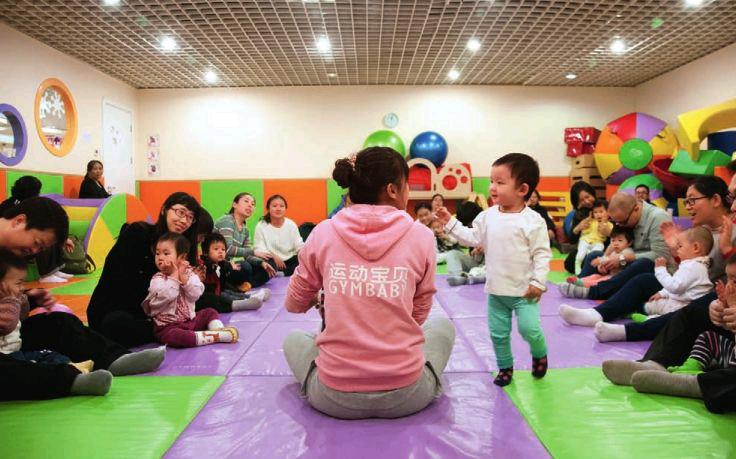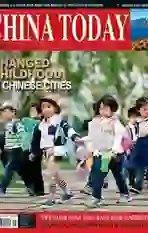Carefree Kiddie-hood: Play to Learn
2014-09-27BystaffreporterZH
By+staff+reporter+ZHANG+HUI
THE newly opened childrens playground in Fangzhuang Sports Park in Beijings Fengtai District has added a heaving hubbub of exuberant youngsters to this otherwise sedate spot where local residents come to relax or take exercise. Built to accommodate the recreational demands of children born in the recent baby boom, the playground is amply equipped with swings, roundabout, sandpit, Thomas the Tank Engine, corsair, rotating plane, and a paddling pool. Three-year-old Lin Yitong is a regular visitor here.
“With equipment like this to play on, children today have every reason to be happy,” Yitongs mother Wang Fang remarked.
Chinas economic development has empowered the government to build the many childrens theme parks and clubs that have sprung up in recent years. It has also enabled parents to provide manifold sources of fun for their offspring.
Wang Fang was born in the late 1970s in Handan, North Chinas Hebei Province.
“My only toy was the rag doll my mom gave me for my fifth birthday. In autumn I would happily play for hours with the fallen leaves in our yard,” Wang said. This memory is in sharp contrast to the play zone in Wangs apartment, and the cupboard overflowing with Yitongs building blocks, remote control gadgets, toys with flashing lights and music, and action figures modeled on TV cartoon characters.
A wave of nostalgia recently swept the Internet, apparent in shared recollections of the beanbags, slingshots, iron hoops, spinning tops, and marbles that people born in the 1970s played with during their childhood.
The dramatic changes in games and toys are attributable to the equally radical economic and demographic transformations China has experienced during 30-plus years of reform and opening-up. In 1978, Chinas urban per capita disposable income was RMB 343.3. By 2012 this figure had soared 71-fold to RMB 24,565. Similarly, census data show that the average urban family in 1978 comprised 4.56 members, a figure that by 2010 had almost halved to 2.86 people per household; also that in 1982, only 599 people out of every 100,000 had received college education, a number that by 2010 had leapt to 8,930.
New Parenting Mode
The current 1-2-4 – one child, two parents, four grandparents – family structural norm will inevitably change due to relaxation of Chinas birth control policy. But right now the sole child of the family, while apple of everyones eye, has no playmate.
“Although our material needs are more than satisfied, I know that my little girls life is lonely without a sibling,” 37-year-old Zhang Lifen said. Zhang often networks with colleagues and friends that have children of a similar age to her nine-year-old daughter to organize gettogethers or outings where the youngsters can play together.
“Im not looking for a place with multi-activities for kids. I just want her to have playmates her own age,” Zhang said.
Forums on certain websites are inundated with posts from parents seeking other families with children, often from different regions, to go on outings to the same destination.
“You cant always find local acquaintances willing to go on outings, so online platforms are helpful. Besides, being with children from different regions gives my child the chance to learn about different customs and dialects, which is fun for him,” six-year-old Ji Zhes mom said. Beijing born and bred, Ji Zhe has already been to Gansu and Shaanxi with his mother and families from other regions.
The Internet provides multiple communication platforms. Parents benefit from this trend as it gives them easy access to a full range of parenting information and experiences. More importantly, it provides opportunities to meet other families in person and enjoy activities together. Wang Xiaoying, mother of two-and-half-year-old boy Yueyue, keeps a constant eye on such platforms.
“These activities are mostly free, and usually improving,” Wang told China Today.
Parenting forums on certain web portals often join hands with early childhood education institutes or childrens recreational centers in activities like parent-children games, drawing and handicrafts. They give children the chance to play with their peers and so develop social skills. This is particularly important for children below the age of three, because most kindergartens in China only accept children above that age. Until then, they are solely under parental care.
Yueyues family lives in Huilongguan Community of Beijings Changping District. His grandparents look after him while his parents are at work.
“Yueyues grandparents do well at taking care of his meals and other daily life needs, but less so at guiding him to control his emotions and develop social skills, or at tapping his intelligence potential,” Wang said.
Early Education, Happy Childhood
“Theres a two-year-old boy at our center whose grandparents look after him. Before coming here, he mainly played by himself. He wasnt very talkative because his grandparents didnt communicate with him all that much,”education consultant at Beijing R.Y.B. Fangzhuang Learning Center Wang Shiwei said. Wang added that as both the childs parents are busy with work they have no time for hands-on parenting. Understanding that the boys grandparents are ill-equipped to educate the child, they decided to send him to the early education center.
Children generally attend early education classes at the center to instill in them a sense of order, to improve their attention span, and to nurture their social skills. Parents also hope to tap childrens potential while they are still in infancy.
“Our classes are designed, through a wide range of games and activities, to develop childrens faculties, tap their potential, help them focus, cultivate their ability to solve problems, and nurture their team spirit,” Wang said.
Parents are also expected to attend these early education classes. “As well as helping their children and encouraging them to cooperate, they can also learn parenting skills and early education concepts and methods that make our classes even more effective,” Wang explained.
Founded in 1998, the R. Y. B. early education institute was one of the first of its kind in China. Back then, parenting classes featuring parent-child games were a new concept. Today, various types of early childhood education centers have a presence in almost every community in Chinas urban areas.
Eight-month-old Zhu Xiaoyan is a regular at the Chongwenmen Gymboree Center. Apart from the two classes he attends at weekends with his parents, Xiaoyans membership also gives him carte blanche to play whenever he likes in its airy, bright, spotlessly clean play rooms with a full range of toys and play facilities. Xiaoyan is one of the younger members of the center, but not the youngest.
“Some babies just three months old come here for training to improve their physical coordination and develop their faculties,” education consultant at the Gymboree center Vicky Wang said.
“Our grandson mixes with other infants here and joins in novel activities, which is why we bring him. Babies, as you probably know, tend to ape othersbehavior, so when he sees others crawling, he also has a try. This is good for his physical development,” Xiaoyans grandfather told China Today.
Parents in the West have enjoyed the benefits of early childhood education for more than a century, but it was not until the 1990s that ordinary Chinese parents knew of it. This is why many jump at the chance to bring their children to Gymboree – a respected international early childhood education brand.
“Im convinced of the benefits of early education. Having studied abroad, I know how popular it is in France and Germany. My son has been a regular visitor to this center since he was five months old. Although costly, I think the expense is worthwhile. The benefits to children of early education occur through a gradual, often imperceptible process. It plays an important role in cultivating childrens characters, and can help them control their emotions,”two-and-half-year-old Tutus mother told China Today.
It is plain to see that children at early education centers are generally carefree and happy. Unburdened with study assignments, they learn about the world through play, how to get along with other children through games, and develop their imagination and creativity through well-designed activities.
Early Cultural Enlightenment
The reading materials of most Chinese children of the 1970s and 1980s were xiaorenshu – palm-sized picturestory books. Their content comprised stage photos of TV plays, cartoons, and illustrations of Chinese classics or stories from overseas with captions. As pictures and words were equally important in following the plot, xiaorenshu best suited children who had learned a certain number of Chinese characters. Reading materials for children who had not, however, were scarce. Nowadays, there is a dazzling variety of picture books for children, even for infants. Their content no longer confined to classical stories, most of them, Chinese or otherwise, are specially designed to foster childrens cognitive skills, powers of observation and imagination.
“I began to show Dingding picture books when he was six months old, to help him understand his physical features and environment. Little Hands, Come Out helped him identify parts of his body. Later, I bought him When Soup Spills, Wipe It Up. Its so rewarding to see him ape the behavior shown in the book and clean up spilled liquids. He is now two and half years old, and likes story books that have plots involving conflicts,” Dingdings mother Yang Le told China Today.
As prices of most picture books range from RMB 10 to RMB 20 or more, and Dingding doesnt always like the ones his mother selects, Yang Le decided to join a book club. Her borrowers card enables her to browses shelves full of picture books.
Childrens picture book clubs, mostly privately run, are a new, growing presence in Chinas urban areas. Fundamentally libraries, they also organize childrens activities, like physical training classes, readers meetings, story-telling sessions, and games. In this way they act as community activity centers where children can make friends, learn and play together.
Recently, the picture book club Yang belongs to started an activity where children tell stories and draw accompanying illustrations.
“After reading so many picture books, kids have enough input to make up their own stories. They show children both how to structure and illustrate stories. Although a challenge, its good training for them,” Yang said.
As for cultural life, children in Chinas urban areas have diverse choices. There are several childrens theaters in Beijing, notably a puppet theater that holds regular performances. Children keen on acting can also join community drama clubs.
The central government has long manifested care and concern in promoting childrens healthy development. All Chinese newborns are entitled to free vaccinations at local community health service stations. Local authorities also support the charitable foundations throughout China that help children in need. One is the China Children and Teenagers Fund that runs the Spring Bud Project, which helps poverty stricken girl dropouts return to school. Others include the Safe and Healthy Growth Project and the Action to Eliminate Anemia amongst Infants and Children. Both aim to improve Chinese childrens comprehensive quality of life and give help to those that fall victim to illness, injury, or crime. All these charity projects are instrumental in promoting childrens healthy development.
Local governments are also proactive in constructing early childhood education bases. The Beijing Municipal Education Commission demonstrated commitment in this regard by declaring support in its 2014 work plan for 300 early childhood community education demonstration bases that give free consultations to families with preschool-age children. In Beijing, children below the age of three have their pick of early education bases where they can join in free activities.
Children constitute the countrys future. Their physical and psychological health and education consequently determine how society will evolve. As attention from all social sectors focuses on childrens healthy, happy development, they will lack nothing, from infancy to high school and beyond.
